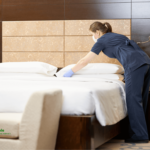Sticky floors are a common nuisance in many homes and businesses. Spilled drinks, food residue, and tracked-in dirt can leave floors feeling grimy and tacky underfoot. While regular mopping helps, it often fails to fully remove sticky messes that have dried on. Restoring floors to a clean, residue-free finish requires targeted cleaning methods. Follow these tips for dealing with sticky spotty floors and keeping them fresh.
Table of Contents
Assess the Mess
Not all sticky floors are created equal. To pick the right cleaning method, you need to identify the source of the stickiness.
- Sugary spills – Spilled fizzy drinks, syrups, and sugary foods leave behind a tacky sugar residue when they dry.
- Greasy spills – Oils and greasy foods like butter and pizza can leave an oily film.
- Grime buildup – When dirt, dust, and debris are ground in by shoes, floors develop a dull, sticky feel.
- Humidity/condensation – In damp spaces like bathrooms, moisture in the air can create a sticky surface as it condenses on floors.
Look closely at the floor to diagnose the type of grime. Check if it feels evenly sticky or if there are isolated sticky spots. This will determine the cleaning methods and products needed.
Prepare the Area
Before scrubbing away stickiness, prepare the space to avoid spreading messes:
- Clear away any furniture or rugs from the area.
- Sweep or vacuum up any loose debris. This prevents grinding it into the floor while scrubbing.
- Remove any solid spills by scraping gently with a spatula or spoon. Take care not to scratch the floor surface.
- Lay down towels around the perimeter to contain drips and splashes.
Protecting surroundings saves time cleaning up later. Now the space is ready for sticky spot removal.
Combine Heat and Moisture
One of the most effective ways to loosen sticky residue is by applying heat and moisture. This dissolves sugary or greasy films for easier removal. Cleaning methods using this principle include:
Steam Mopping
A steam mop superheats water into hot vapour that penetrates and liquefies sticky messes. Steam also sanitises floors. Use a clean pad and slowly mop over sticky areas, allowing the steam to penetrate for 10-15 seconds before scrubbing.
Hot Water Scrubbing
Bring water just shy of boiling point in a bucket. Dampen a scrub brush or cloth in the hot water and scrub affected areas. The heat helps dissolve sticky residues. Avoid excessively hot water that could damage some floor types.
Vinegar and Water Solution
Mix equal parts white vinegar and hot water. Vinegar helps cut through grease and grime. Dip a stiff scrub brush and work into sticky spots using small circular motions. Avoid vinegar solutions on stone floors, which it can etch.
Follow up any heat treatment by mopping with clean water to remove lifted residue. A touch of mild detergent boosts cleaning power.
Break Out Heavy Duty Cleaners
For stubborn sticky spots or greasy build up, use heavy duty cleaners specifically formulated to dissolve and lift away residue:
Enzyme Cleaner
Enzyme-based cleaners use natural enzymes that attack and digest organic compounds like food, oils and grease. Spray or wipe over sticky areas, allow to sit 5-10 minutes, then wipe away.
Degreasing Cleaner
Look for cleaner made for cutting greasy residue. Degreasers like Mr Muscle contain surfactants that emulsify oils, allowing them to rinse away with water. Use gloves when handling.
Baking Soda Scrub
Baking soda’s gritty texture lifts dirt while its alkaline base dissolves grease and sugars. Make a paste with equal parts baking soda and water. Scrub onto floors with a brush or cleaning cloth, then rinse. Avoid on natural stone, which baking soda can scratch.
Spot test heavy duty cleaners first on an inconspicuous area to ensure they don’t damage the flooring.
Daily Prevention
While occasional deep cleaning tackles sticky buildup, certain habits prevent it recurring:
- Quickly wipe spills when they occur so they don’t dry and adhere.
- Sweep, mop or vacuum daily to prevent dirt buildup.
- Use floor mats at entrances to reduce tracked-in grime.
- In damp areas, improve ventilation and use a dehumidifier to control moisture.
- Seal and recoat floors regularly to protect the surface from stains.
With the right techniques and regular care, you can keep floors free of sticky spots for cleaner, fresher floors. Contact Affordable Cleaning and Gardening Services for professional floor cleaning services across the Parramatta region. Our skilled cleaners tackle sticky mess restoration and provide ongoing floor care to keep surfaces clean. Get an instant quote by calling our friendly team today.
FAQ
✓How do you clean old, built-up sticky spots?
For stubborn sticky spots that have set in over time, use a heavy duty degreasing cleaner or baking soda scrub. Apply and let sit for 5-10 minutes before scrubbing and rinsing. Repeated applications may be needed for ingrained sticky spots.
✓What natural cleaner removes sticky floors?
White vinegar effectively breaks down sugary and greasy residue. Mix equal parts vinegar and hot water and scrub onto sticky spots before rinsing clean. Baking soda also acts as a gentle abrasive cleaner for sticky buildup when made into a paste with water.
✓Can you steam mop engineered hardwood floors?
Use caution when steam mopping engineered hardwood. Excessive moisture from steam can damage the adhesive between layers. Look for low-moisture steam mops made for sealed hardwood floors. Test first in an inconspicuous spot and make sure not to over-wet the boards.
✓Why does my vinyl floor feel sticky?
On vinyl floors, stickiness is often caused by the floor finish breaking down and residue adhering to the stripped surface. Deep clean then reapply new layers of vinyl floor sealer to protect the surface. Ensure the floor is completely dry first or the sealant may not adhere properly.






